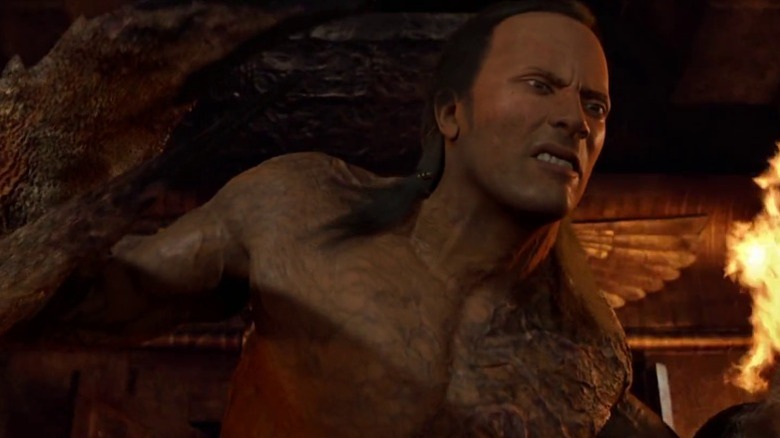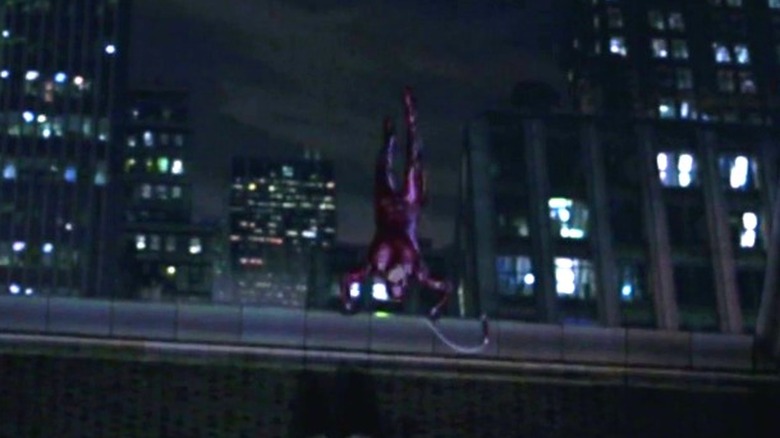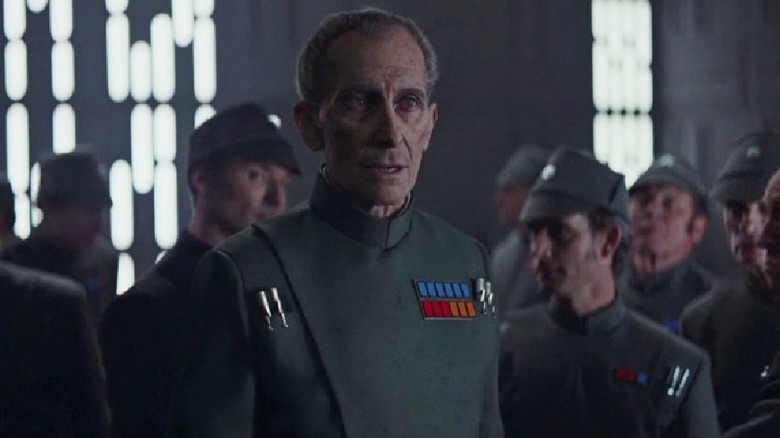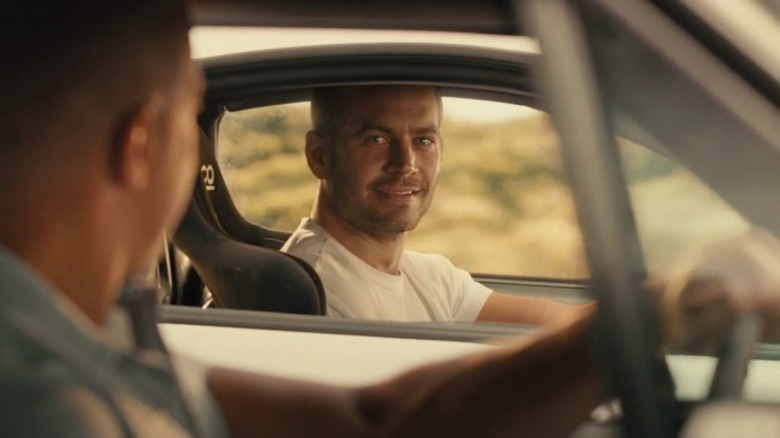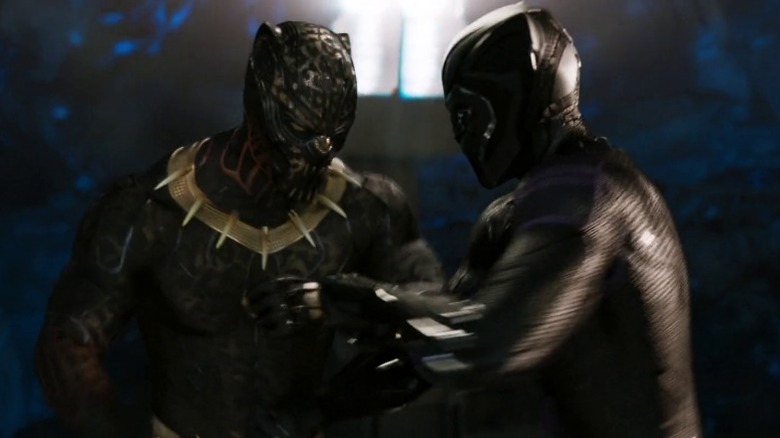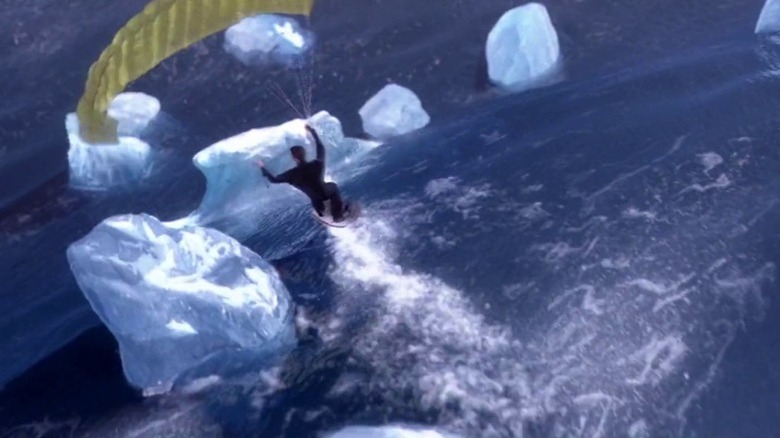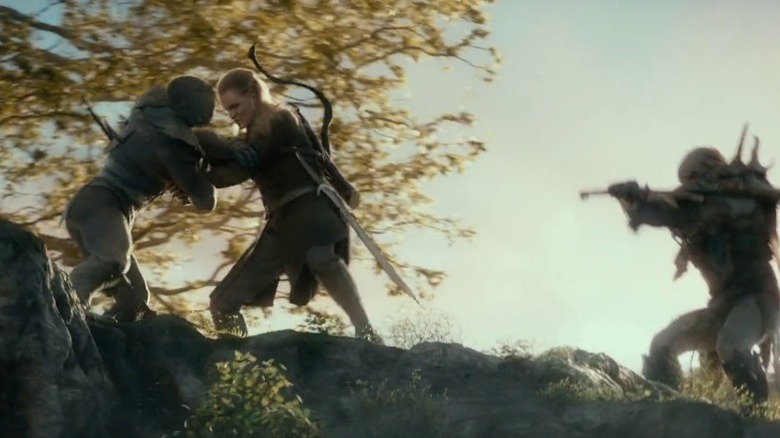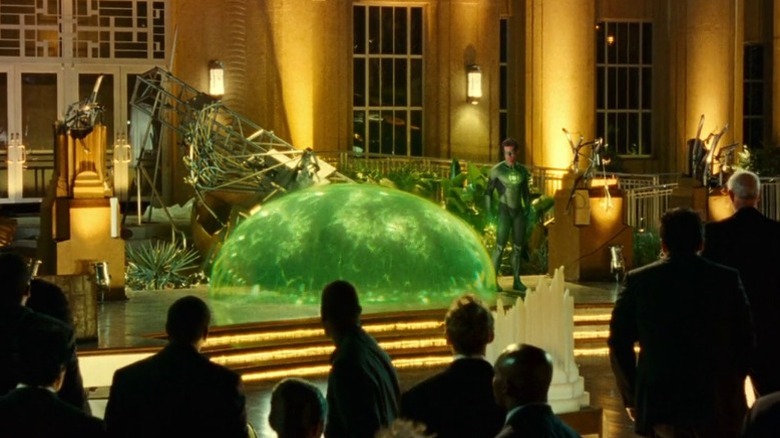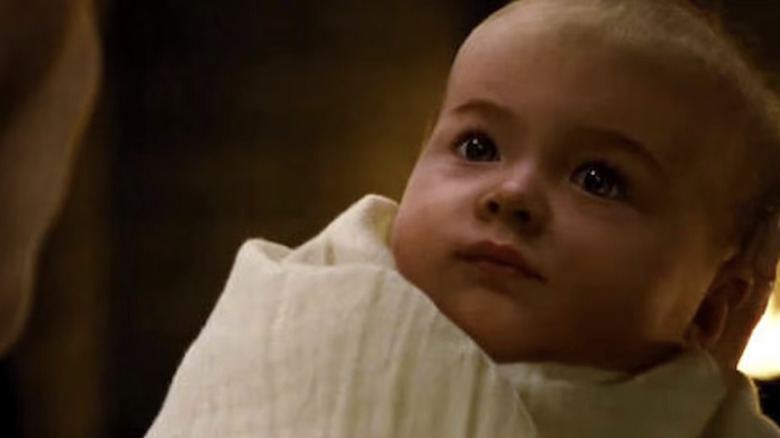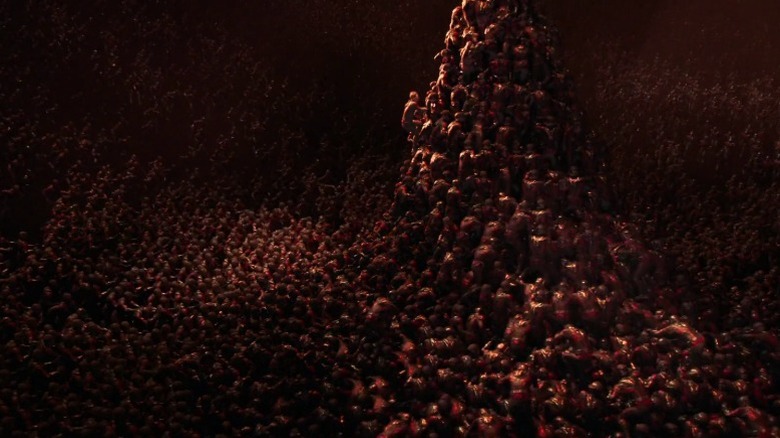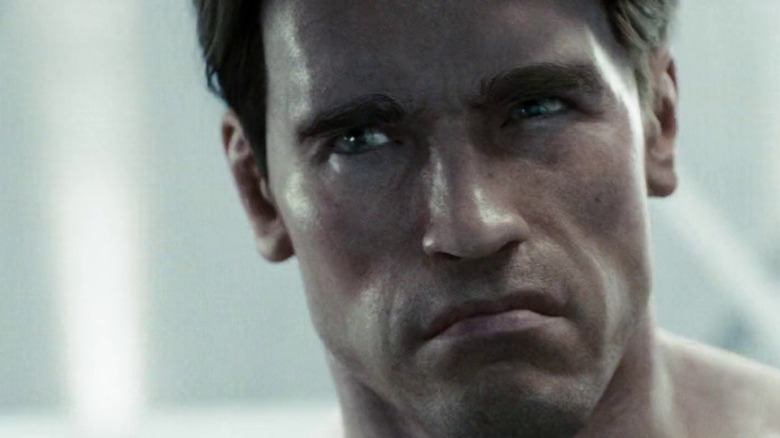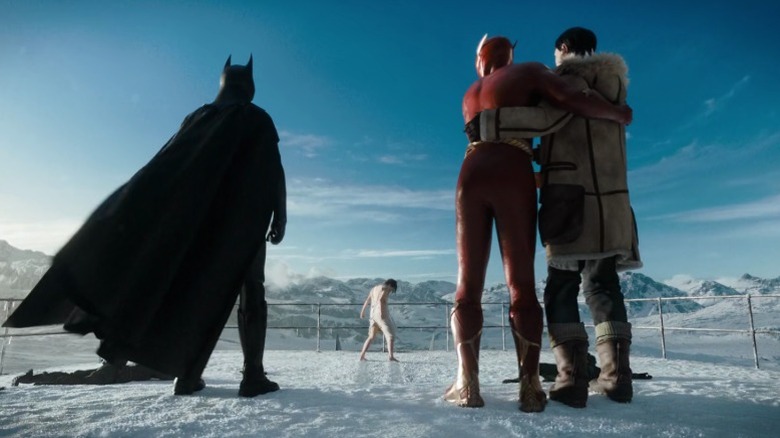Terrible CGI Actor Replacements That Fooled Nobody
The history of film is peppered — or better yet, littered — with examples of terrible, movie-ruining special effects, both digital and practical, being used to replace actors in specific shots and sequences. But there's something uniquely, morbidly fascinating about a bad CGI model suddenly swooping in to take over from a live performer. The three-dimensional, too-smooth quasi-reality of poor CGI makes its shoddily-disguised use in place of actors more than a matter of uncanniness; it's usually not so much that they don't look like real scenic elements, but that they don't look quite human.
To celebrate unconvincing CGI stand-ins in all their bizarre, occasionally hilarious glory, we've compiled a list of 12 particularly egregious instances of CGI actor replacements that fooled absolutely nobody. Some are head-to-toe CGI models given insufficent shading and overly crude movements; some are digital likenesses not-quite-successfully pasted over live performances; and one is a haphazard attempt to make up for what would have been an even worse practical effect. Have some eye drops at the ready.
Dwayne Johnson in The Mummy Returns
Perhaps the single most infamous example of a CGI model disastrously standing in for a real actor is the appearance of Mathayus of Akkad, aka the Scorpion King, in "The Mummy Returns." The 2001 sequel to 1999's "The Mummy" brought back Brendan Fraser, Rachel Weisz, John Hannah, Patricia Velásquez, and more from the original film, joined by a then-novel cast addition: celebrity wrestler Dwayne "The Rock" Johnson, then 29 years old and making his film acting debut.
Following a brief live-action appearance by Johnson in the film's prologue, the Scorpion King reappears in the movie's climax, this time transformed into a monstrous, 100% CGI human-scorpion hybrid modeled after Johnson's likeness — and the human part, to say the least, isn't exactly convincing.
Although the CGI in "The Mummy Returns" has aged relatively well for a 2001 movie so heavy on digital wizardry, the Scorpion King still sticks out like a sore thumb, all but imploding the film's action-packed finale by rendering its would-be menace completely flat. The Scorpion King's final form feels so uncanny, unreal, and just plain goofy that there's no suspense to Rick O'Connell's (Fraser) fight with him. The botch job was reportedly a result of the movie's CGI team having limited access to Johnson due to his busy WWE schedule — resulting in a model that bears so little resemblance to the real-life Johnson that it might as well have been designed from memory.
Ben Affleck in Daredevil
Years before the character was brought roaring back into the pop culture limelight by his Netflix and Disney+ series, Marvel's Daredevil got an infamous 2003 film adaptation, written and directed by Mark Steven Johnson and starring Ben Affleck as Matt Murdock aka Daredevil, Jon Favreau as Franklin "Foggy" Nelson, Jennifer Garner as Elektra Natchios, and — in the movie's most inspired feat of casting — Michael Clarke Duncan as Wilson Fisk.
Barely breaking even financially, Johnson's "Daredevil" was heavily criticized by fans for failing to capture the spirit of the "Daredevil" comics, beginning with an overly silly and fantastical tone. That lack of seriousness and grounding was reflected in many of the film's technical aspects, including the CGI work used to bring Affleck's Daredevil to life in some of the more elaborate and acrobatic stunts.
Rather than prioritize live-action stunt work and choreography like the character's later TV iterations, the 2003 "Daredevil" frequently resorts to replacing Affleck wholesale with an all-digital version of the suited-up Man Without Fear, and it rarely looks functional — let alone convincing. Shots of Daredevil leaping through rooms, up walls, and out of buildings consistently look like video game cutscenes, with a 3D figurine suddenly replacing Affleck as if we wouldn't notice.
Peter Cushing in Rogue One
The 2016 "Star Wars" prequel, "Rogue One: A Star Wars Story," went down in history for several reasons. It was the first "Star Wars" theatrical film to depart from the stylistic template of the Skywalker Saga, the first to tell a lateral story, the first not to feature John Williams as composer, and it ultimately became the basis for one of the strongest "Star Wars" spinoffs ever in the Disney+ series "Andor."
But the single most notorious aspect of "Rogue One" in the overarching timeline — not just of "Star Wars" but of Hollywood filmmaking — may have been its use of a digital recreation of the late Peter Cushing. The British actor, who died in 1994, played Grand Moff Tarkin in the original 1977 movie, "Star Wars." Rather than recast the part, the makers of "Rogue One" opted to seek permission from Cushing's estate to create a CGI model of him and superimpose that model over English actor Guy Henry in post-production.
As a result, several stretches of "Rogue One" are dominated by a stiff, uncanny version of Tarkin that looks and moves just enough like Cushing to make it glaringly obvious that it's not Cushing there at all. In many ways, that ethically and cinematically dubious choice opened the door for the ongoing normalization of estate-authorized pseudo-necromancy via digital effects. And to think they could have just cast a new actor.
Paul Walker in Furious 7
Speaking of resurrecting actors with CGI, there are some instances in which the choice to create digital approximations of late actors is at least informed by more than strict "why the heck not" amorality — such as when actors pass away midway through production. 2000's "Gladiator" was hampered by such an issue when Oliver Reed died with several scenes featuring his Proximo left to shoot; the Ridley Scott film solved the problem by superimposing Reed's face over a body double, so seamlessly that you might not even have noticed it.
In the case of "Furious 7," however, the work of completing an actor's performance via CGI was much more conspicuous. Unlike "Gladiator," which wisely kept Proximo's digitally-assisted scenes shrouded in shadow and photographically similar to previous appearances by Reed in the movie, "Furious 7" all but flaunted its CGI recreation of the late Paul Walker in several key shots.
Several of those shots, in fairness, are seamless. But director James Wan was confident enough to place the digital Brian O'Conner — created by placing Walker's face over the bodies of his brothers Caleb and Cody, and/or actor John Brotherton — square at the center of the film's emotional climax, in which Brian and Dominic Toretto (Vin Diesel) bid each other farewell on the road. The intention to honor Walker's memory is understandable and noble, but in practice, the shot produces a poorly-timed brush with the uncanny valley that distracts from the intended emotion.
Chadwick Boseman and Michael B. Jordan in Black Panther
"Black Panther" still stands as one of Marvel's best movies years after its release, not to mention one of the most expansive, thorough, and impressive technical feats in the whole MCU. From its costumes to its art direction to its bright-colored cinematography to its elaborate stunt choreography to its gorgeous musical score, Ryan Coogler's 2018 Afrofuturist epic is a feat of perfectionism and imagination that puts most Hollywood blockbuster movies to shame. It's no wonder that it changed the Oscars forever with several history-making nominations, and became the first MCU movie to actually win (multiple!) Academy Awards.
But it's also not much of a surprise that the visual effects of "Black Panther" were not even nominated, as they're notably the film's only technically substandard aspect. The generally rubbery and weightless CGI of "Black Panther" sometimes poses a problem in the film's otherwise lushly immersive design. But the one moment in which it actively compromises the film's storytelling is during the final fight between T'Challa (Chadwick Boseman) and Killmonger (Michael B. Jordan) in the Wakanda vibranium mines.
With both characters wearing full-body suits, the film opts to momentarily replace the performers with all-digital models to facilitate an elastic, gravity-defying action sequence. But due to shoddy CGI work, the end result feels less like the physically expressive denouement to a tragic interpersonal conflict and more like watching two characters duke it out in a PlayStation 3 fighting game.
Pierce Brosnan in Die Another Day
Pierce Brosnan's four films as James Bond marked the raucous, sometimes chaotic transition period between the franchise's slick, campy Cold War spy thriller era and the blooming Hollywood blockbuster age of the '90s and 2000s. As the franchise's set pieces became more bombastic and maximalist, they also became more reliant on CGI of wildly varying quality — and Pierce Brosnan's final Bond film, 2002's "Die Another Day," features perhaps the most regrettable example of the series overreaching technologically in the name of would-be spectacle.
We're referring, of course, to the tidal wave surfing scene, which occurs when Bond is escaping Gustav Graves' (Toby Stephens) Iceland facility while being pursued by the ice-melting Icarus satellite. Most of the scene features a live-action Brosnan surrounded by CGI water and glaciers, accomplished through blue screen chroma keying — and those stretches look silly enough. But then, at key points, the sequence has Bond pull off gravity-defying feats by replacing him with a CGI model of Brosnan. Even seen from behind, the model in those shots is entirely unconvincing.
It's one of the most notorious instances of overly ambitious CGI mucking up an otherwise engaging early-2000s action-fest. No wonder the series immediately reverted back to a more grounded and practical style for the subsequent Daniel Craig installments.
Orlando Bloom in The Hobbit: The Desolation of Smaug
Fittingly for a middle chapter unencumbered with either table-setting or wrapping-up, 2013's "The Hobbit: The Desolation of Smaug" is the only decent movie in Peter Jackson's bloated "The Hobbit" trilogy, if only due to its baseline functionality as a simple, fun, and straightforward action-adventure romp. The film's various action sequences are big, well-assembled, and entertaining enough to almost recapture the technical grandeur of the "Lord of the Rings" trilogy, if not quite its dramatic and artistic sturdiness.
An unexpected high point is the three-way river battle between the Dwarves, the Wood-elves, and the Orcs, which forgoes any somberness and veers into straight-up cartoon logic, carried out with delightful abandon by Jackson and his tech team. That said, even as the sequence's goofiness proves to be an asset, there's no denying that the CGI models that sub in for the actors during most of the wide shots feel less than lifelike. And Legolas' (Orlando Bloom) various showy scuffles with the Orcs around the rocky riverbanks are by far the worst offender.
Save for occasional split-second cuts to Bloom looking around and shooting arrows, Jackson doesn't even try to splice in the CGI Legolas with any practical action. In shots where the shaky-cam slows down enough to give us a good glimpse of Legolas, he suddenly feels less like a flesh-and-blood character than the Orcs.
Ryan Reynolds in Green Lantern
Director Martin Campbell's 2011 "Green Lantern" movie has become one of the go-to answers to the prompt "What are the worst superhero movies ever made?", thanks to its bungling not only of the Green Lantern comics but virtually all rules of action filmmaking, quality storytelling, and good taste. Criticizing its poor visual effects is pretty much beating a dead horse at this point, but still, no list of terrible CGI actor replacements would be complete without citing this movie's utterly sloppy digital rendering of suited-up Hal Jordan (Ryan Reynolds).
The character suits in "Green Lantern" were infamously created and added in digitally instead of being actually worn by the actors on set — which creates the bizarre effect of watching Reynolds' actual head seemingly float above a flimsy mass of green CGI. As if that baffling artistic decision wasn't bad enough, several shots in "Green Lantern" cut out the middleman entirely and just have Jordan's head animated with CGI as well, effectively replacing Reynolds with a fully digital and utterly unconvincing Green Lantern.
The fan distaste for the movie's overreliance on hamfisted CGI was so great that it was later referenced in "Deadpool," which finds Reynolds' Wade Wilson requesting that his super-suit not be made "green or animated." Funnily enough, both "Deadpool" films do feature 100% CGI models of Deadpool in several shots, which goes to show that the problem is less the CGI use itself and more its thoughtlessness and lack of quality.
Baby Renesmee in The Twilight Saga: Breaking Dawn - Part 2
Every other item on this list is an instance of one or more human actors being replaced by CGI compositions. But one of the most egregious examples in movie history of a human character in a live-action movie being rendered through bad CGI involved no flesh-and-blood actors at all. It did involve a puppet, for what that's worth — but said puppet could not, by any stretch whatsoever, be called anything close to "human."
In fact, the real conundrum when looking at baby Renesmee in the final "Twilight" film, 2012's "The Twilight Saga: Breaking Dawn — Part 2," is determining whether its ultimate onscreen form was better or worse than its would-be practical conception. To be clear, the CGI baby in "Breaking Dawn — Part 2" is a complete catastrophe as far as digital design of human characters is concerned. Even conceding that there's supposed to be something uncanny and inhuman about Bella (Kristen Stewart) and Edward's (Robert Pattinson) human-vampire hybrid infant, the CGI baby Renesmee looks like she's not even there — like Rosalie (Nikki Reed) and then Bella are not cradling anyone or anything at all in their arms.
But the digital Renesmee might still have been an improvement over the filmmakers' original plan to bring the baby to life via animatronic puppet. CGI Renesmee is at least a cute enough baby, even if she doesn't look real at all; behind-the-scenes images of the ultimately scrapped puppet Renesmee, meanwhile, are outright terrifying.
Paul Rudd in Ant-Man and the Wasp: Quantumania
The decaying quality of the CGI in the post-2019 Marvel Cinematic Universe has been the topic of much discussion among fans and skeptics alike, with the diminishing returns seemingly stemming from a combination of harsh workplace conditions for CGI artists and general carelessness and poor judgment on the part of directors and producers. As far as laziness and creative apathy are concerned, the absolute nadir of MCU visual effects may well have been 2023's "Ant-Man and the Wasp: Quantumania."
A largely lifeless, unengaging, and bureaucratic film from top to bottom, "Quantumania" features some of the least polished CGI in the last few years of comic book cinema, as demonstrated by many if not most of the shots featuring Scott Lang (Paul Rudd) in his Ant-Man suit. During the power core scene, in particular, the whole point of the probability storm shenanigans is that we're supposed to feel as though Scott is being besieged on all sides by versions of himself. Yet the effects in that scene feel at least a full decade older than they are, resulting in the questionable experience of nothing but Rudd's center-stage figure — and sometimes nothing but his head, and sometimes not even that — actually feeling real and tangible.
That's far from the only set piece in the movie that presents such problems. We've had our fair share of not-so-great MCU movies, but "Quantumania" often actively gives off the impression that the filmmakers weren't even concerned about making the movie look good.
Arnold Schwarzenegger in Terminator Salvation
If you want to know the reason why 2009's "Terminator Salvation" isn't discussed or remembered all that often by fans of the franchise, the shortest and simplest explanation is that it is not very good. Another big reason is that it is the only one of the six existing movies not to feature Arnold Schwarzenegger (who had his hands full with the whole "governor of California" thing at the time) as the Terminator — which would seem to be a pretty big baseline requirement for a "Terminator" movie.
Even so, "Terminator Salvation" exists, sans Schwarzenegger, and the movie works around the absence of the franchise's face and biggest star by recreating his likeness digitally. For most of the movie, in shots where the face of the T-800 is not clearly visible, the character is portrayed by Austrian actor and bodybuilder Roland Kickinger, who played Schwarzenegger in the 2005 made-for-TV biopic "See Arnold Run."
Then, in one key fight sequence featuring several close-up shots of the T-800's face, Schwarzenegger's face is digitally superimposed over Kickinger's body. The final result goes about as well as you'd expect such an ambitious and complex CGI effect to go in an McG-directed 2009 movie, which is to say, not well at all.
Ezra Miller in The Flash
It's no secret to anyone that 2023's "The Flash" is an agreeably terrible movie, James Gunn's love for it notwithstanding. But as much as we've harped on how bad its writing, acting, direction, cinematography, and visual effects are, it still feels like we've only scratched the surface. Every new viewing of "The Flash" — if you're willing to put yourself through multiple viewings — reveals new layers of mind-boggling badness.
On a first watch, you may find yourself too distracted by the mushy, headache-inducing confusion and visual incoherence of the movie's action sequences to notice the frequency with which "The Flash" resorts to needless CGI actor replacement even in quiet moments. It's easy to gawk, for instance, at the amateurish staging and low-grade VFX in the scene where Supergirl (Sasha Calle) fights off the Siberian guards — which features plenty of bad CGI replacement in its own right.
But take a closer look at the scene's very last shot, in which the heroes are rescued by Batman's (Michael Keaton) aircraft, and you will notice that both the suited and the plainclothes version of Barry Allen aka The Flash (Ezra Miller) are stiff, rubbery, barely-shaded digital models. Poor CGI in wild stunts and fast-moving action sequences is one thing, but they couldn't even get two human stand-ins into Barry's clothes for that simple 15-second shot?

